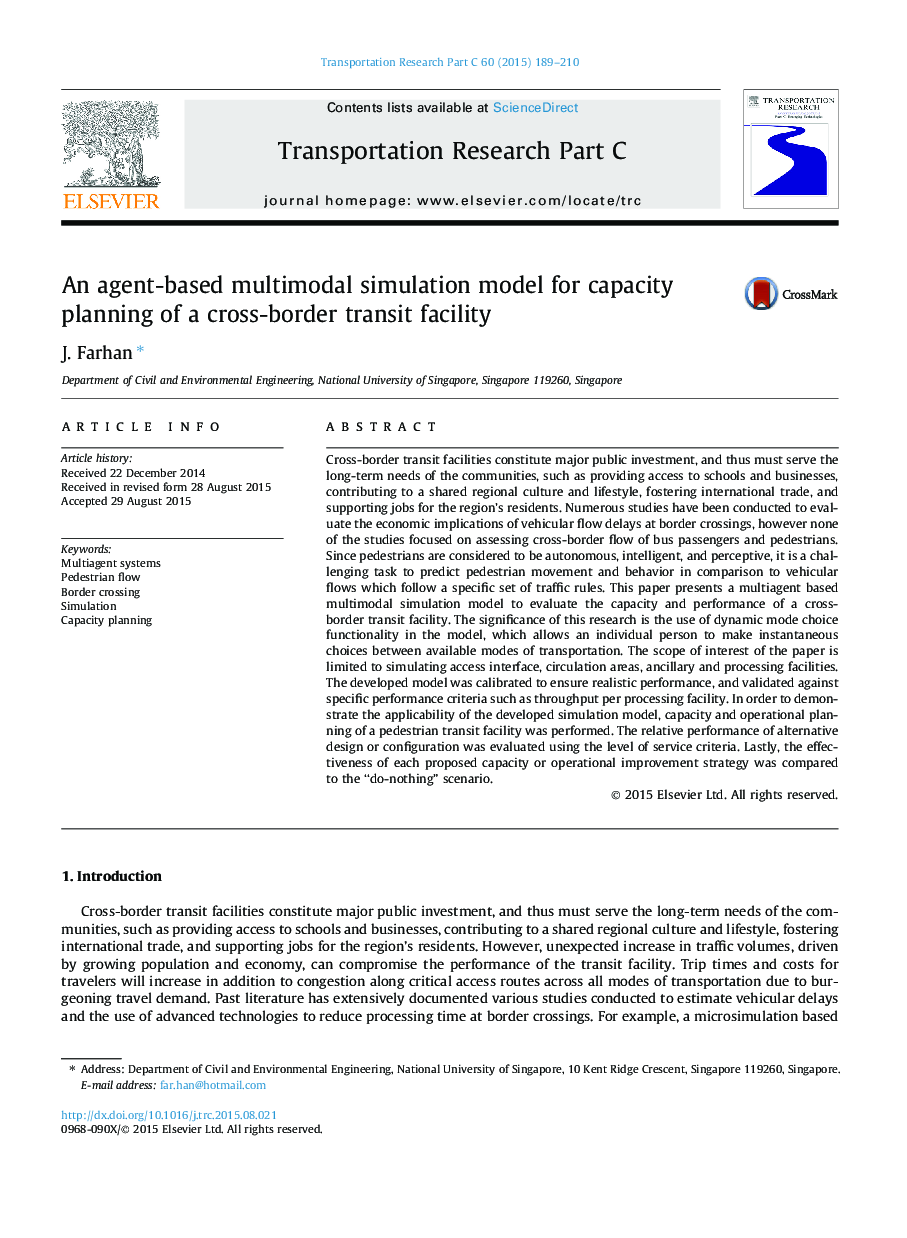| کد مقاله | کد نشریه | سال انتشار | مقاله انگلیسی | نسخه تمام متن |
|---|---|---|---|---|
| 6936588 | 868840 | 2015 | 22 صفحه PDF | دانلود رایگان |
عنوان انگلیسی مقاله ISI
An agent-based multimodal simulation model for capacity planning of a cross-border transit facility
ترجمه فارسی عنوان
یک مدل شبیه سازی چند منظوره مبتنی بر عامل برای برنامه ریزی ظرفیت ترابری بین مرزی
دانلود مقاله + سفارش ترجمه
دانلود مقاله ISI انگلیسی
رایگان برای ایرانیان
کلمات کلیدی
سیستم های چندگانه، جریان عابر پیاده، گذرگاه مرزی، شبیه سازی، برنامه ریزی ظرفیت،
ترجمه چکیده
تسهیلات حمل و نقل بین المللی سرمایه گذاری عمومی عمومی را تشکیل می دهند و بنابراین باید به نیازهای درازمدت جوامع مانند فراهم آوردن دسترسی به مدارس و کسب و کار، کمک به یک فرهنگ و شیوه زندگی مشترک، ایجاد تجارت بین المللی و حمایت از شغل برای ساکنین منطقه. مطالعات متعددی برای ارزیابی پیامدهای اقتصادی تاخیر جریان وسیله نقلیه در گذرگاه های مرزی انجام شده است، اما هیچکدام از این مطالعات بر روی ارزیابی جریان عبور از مسافران اتوبوس و عابران پیاده قرار نگرفته است. از آنجایی که عابران پیاده به عنوان مستقل، هوشمند و درخور توجه در نظر گرفته شده است، این یک مساله چالش برانگیز پیش بینی حرکت و رفتار عابر پیاده در مقایسه با جریانهای جاده ای است که به دنبال مجموعه ای از قوانین ترافیکی هستند. این مقاله یک مدل شبیه سازی چند منظوره مبتنی بر چند منظوره برای ارزیابی ظرفیت و عملکرد یک ترابری بین مرزی ارائه می دهد. اهمیت این تحقیق، استفاده از عملکرد انتخاب حالت پویا در مدل است که به فرد اجازه می دهد انتخاب های لحظه ای بین حالت های حمل و نقل در دسترس را انجام دهد. محدوده مورد علاقه مقاله محدود به شبیه سازی رابط دسترسی، مناطق گردش، امکانات جانبی و فرآیند است. مدل توسعه یافته برای اطمینان از عملکرد واقع گرایانه کالیبره شده و براساس معیارهای عملکرد خاصی نظیر ظرفیت تولید در هر تابع پردازش، مورد تایید قرار گرفته است. به منظور نشان دادن کاربرد مدل شبیه سازی توسعه یافته، ظرفیت و برنامه ریزی عملیاتی یک تاسیسات حمل و نقل عابر پیاده انجام شد. عملکرد نسبی طراحی یا پیکربندی جایگزین با استفاده از معیارهای خدمات ارزیابی شد. در نهایت، اثربخشی هر یک از ظرفیت پیشنهادی یا استراتژی بهبود عملیاتی با "هیچ چیزی" مقایسه شد؟ سناریو.
موضوعات مرتبط
مهندسی و علوم پایه
مهندسی کامپیوتر
نرم افزارهای علوم کامپیوتر
چکیده انگلیسی
Cross-border transit facilities constitute major public investment, and thus must serve the long-term needs of the communities, such as providing access to schools and businesses, contributing to a shared regional culture and lifestyle, fostering international trade, and supporting jobs for the region's residents. Numerous studies have been conducted to evaluate the economic implications of vehicular flow delays at border crossings, however none of the studies focused on assessing cross-border flow of bus passengers and pedestrians. Since pedestrians are considered to be autonomous, intelligent, and perceptive, it is a challenging task to predict pedestrian movement and behavior in comparison to vehicular flows which follow a specific set of traffic rules. This paper presents a multiagent based multimodal simulation model to evaluate the capacity and performance of a cross-border transit facility. The significance of this research is the use of dynamic mode choice functionality in the model, which allows an individual person to make instantaneous choices between available modes of transportation. The scope of interest of the paper is limited to simulating access interface, circulation areas, ancillary and processing facilities. The developed model was calibrated to ensure realistic performance, and validated against specific performance criteria such as throughput per processing facility. In order to demonstrate the applicability of the developed simulation model, capacity and operational planning of a pedestrian transit facility was performed. The relative performance of alternative design or configuration was evaluated using the level of service criteria. Lastly, the effectiveness of each proposed capacity or operational improvement strategy was compared to the “do-nothing” scenario.
ناشر
Database: Elsevier - ScienceDirect (ساینس دایرکت)
Journal: Transportation Research Part C: Emerging Technologies - Volume 60, November 2015, Pages 189-210
Journal: Transportation Research Part C: Emerging Technologies - Volume 60, November 2015, Pages 189-210
نویسندگان
J. Farhan,
